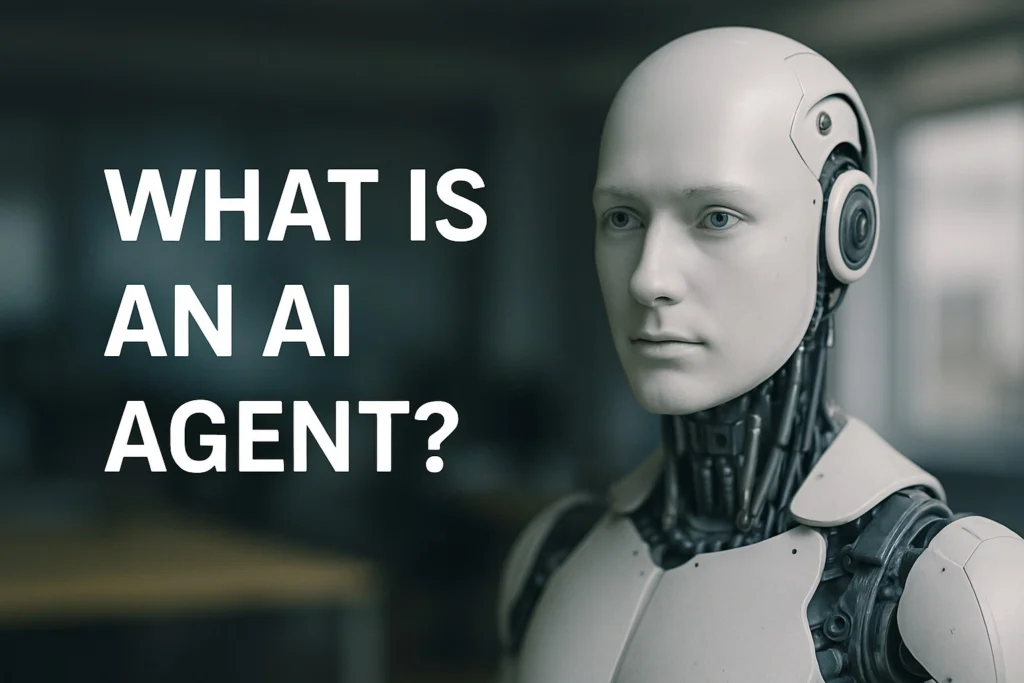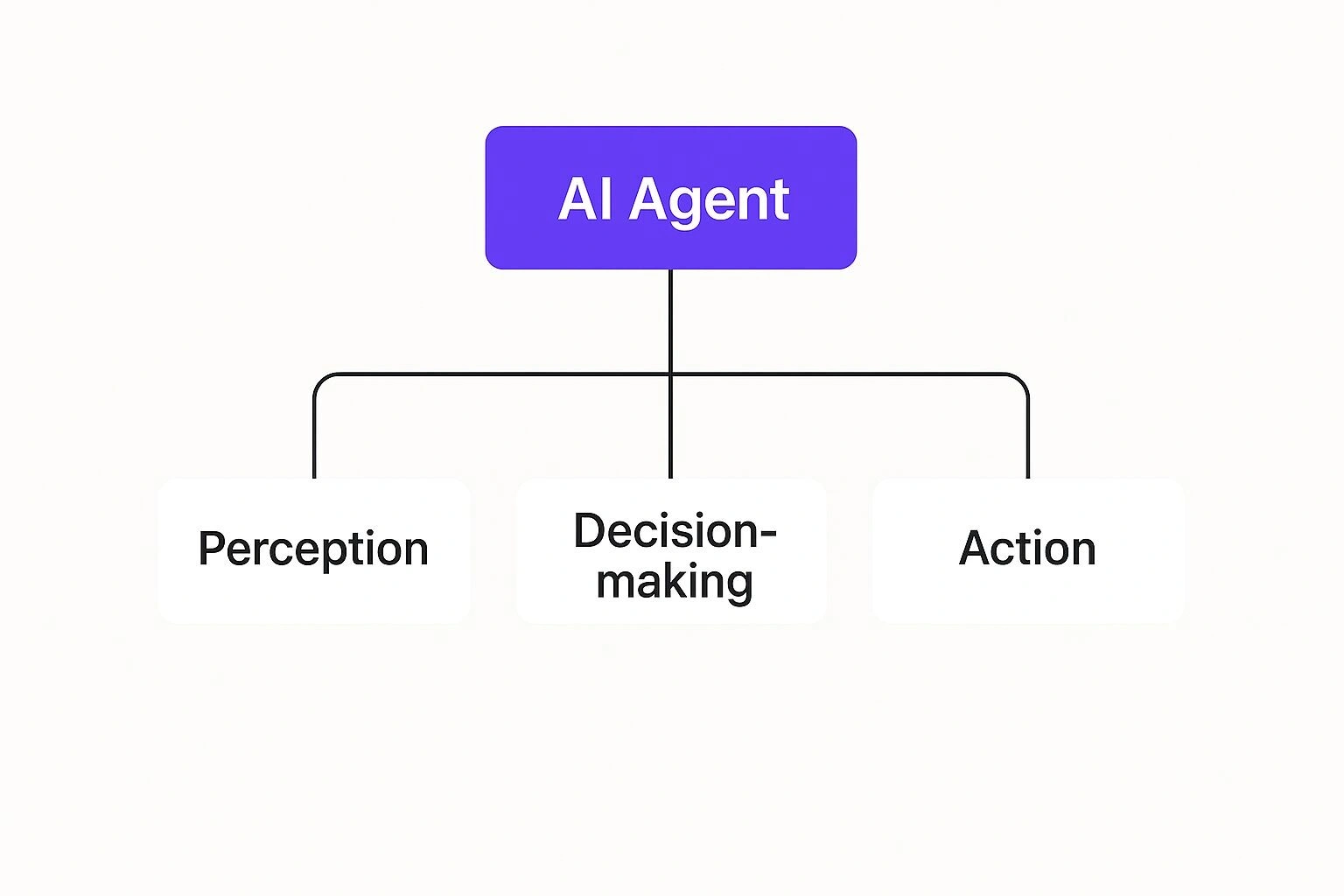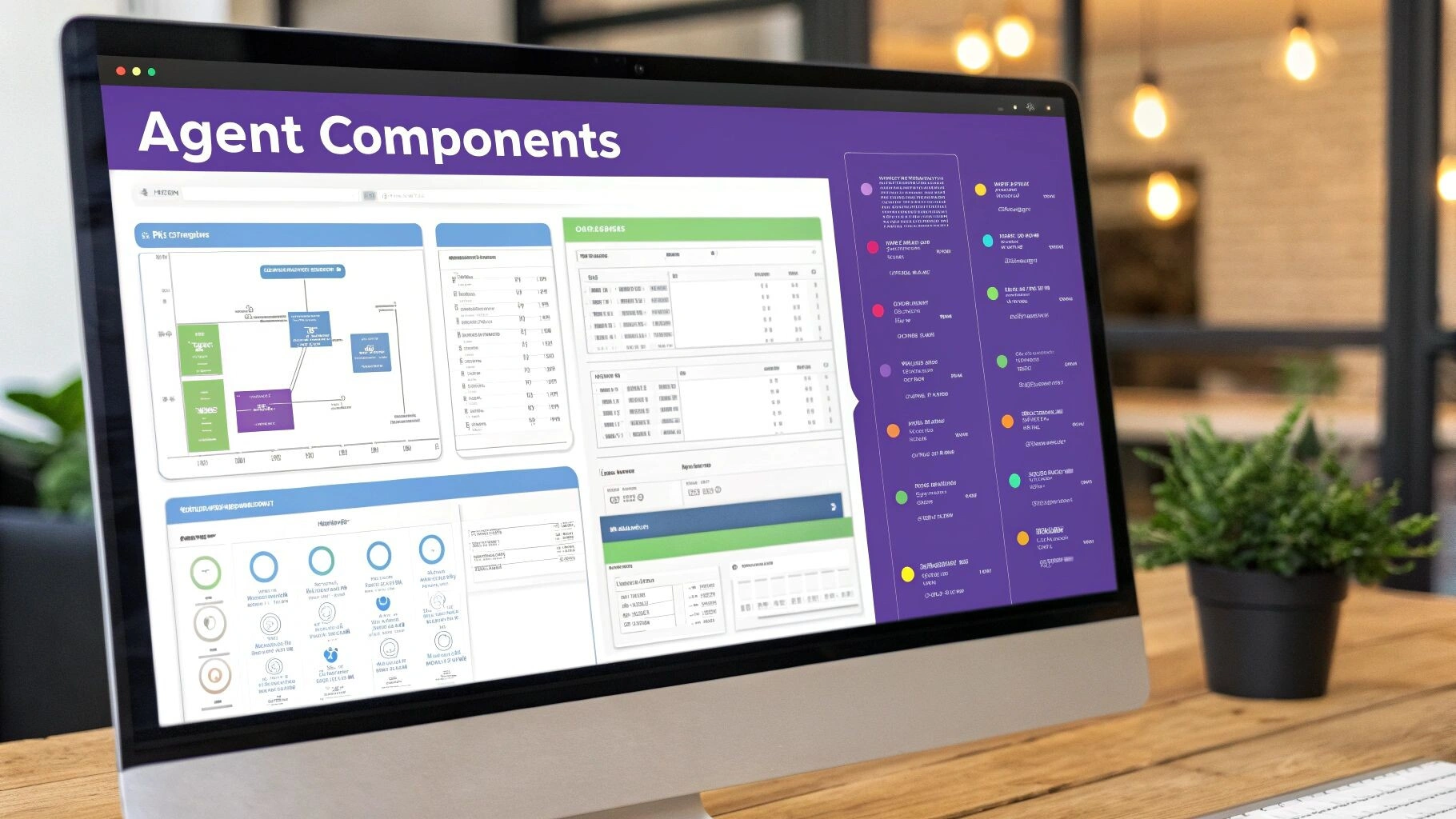What Is an AI Agent? A Guide for Australian Business
Unsure what is an AI agent? This guide explains everything for Australian businesses, from how they work to real-world enterprise use cases and implementation.

When you hear the term “AI agent,” it’s easy to picture a fancy chatbot. But that’s not quite right. An AI agent is an autonomous program that observes its environment, makes its own decisions, and takes action to hit specific goals.
Think of it less like a reactive customer service bot and more like a proactive digital team member, one capable of managing entire projects from start to finish.
Defining an AI Agent Beyond the Hype
Let’s move past the idea of a simple, script-following chatbot. To really understand what is an AI agent, picture an autonomous project manager working inside your business. It operates in a constant loop: perceiving what’s happening in its digital environment, making independent decisions based on that information, and then taking concrete action to achieve a set goal.
This could be anything from optimising a digital marketing campaign in real-time to streamlining complex supply chain logistics, all without needing constant human intervention. The crucial difference is its proactive, goal-driven nature; it’s not just a tool waiting for a command.
The Core Components of an Agent
AI agents get their autonomy from three fundamental pillars. This structure is what allows them to go beyond basic instructions and handle complex, multi-step tasks on their own.
- Perception: The agent constantly gathers and processes information from its digital surroundings. This might be incoming data streams, system notifications, or even shifts in market conditions.
- Decision-Making: Using its core model, often a Large Language Model (LLM), the agent analyses the information it has perceived and formulates a plan to reach its objective.
- Action: The agent then executes that plan. This involves interacting with other software, systems, or APIs to carry out tasks, update records, or even communicate with stakeholders.
This clear sense-think-act cycle is what makes an agent a complete, functional system.

This process is what truly separates an agent from more basic AI. A chatbot might answer a question, but an AI agent can take that same answer and use it to complete an entire workflow.
The distinction between a standard chatbot and a genuine AI agent is significant. While both use AI, their purpose and capabilities are worlds apart. We’ve put together a simple table to highlight these key differences.
AI Chatbot vs AI Agent Key Differences
| Capability | AI Chatbot (Reactive) | AI Agent (Proactive & Autonomous) |
|---|---|---|
| Primary Function | Responds to user queries based on pre-defined scripts or knowledge bases. | Independently performs multi-step tasks to achieve a specific goal. |
| Interaction Style | Reactive. It waits for a user to initiate a conversation and ask a question. | Proactive. It can initiate actions based on triggers, data changes, or schedules. |
| Decision-Making | Limited to providing the best-fit answer from its available data. | Makes complex, sequential decisions, breaks down problems, and plans actions. |
| Scope of Action | Confined to conversation. It can’t typically interact with external software. | Can access and use various tools, APIs, and systems to execute tasks. |
| Example | Answering “What are your business hours?” | Monitoring inventory, re-ordering stock when it’s low, and notifying the supplier. |
As you can see, an agent’s ability to act on its own is what sets it apart. It’s a doer, not just a talker.
An AI agent is best defined by its autonomy. It doesn’t just respond; it reasons, plans, and acts to independently accomplish goals, making it a powerful tool for automating entire business processes.
AI agents are already moving far beyond simple conversational tools. They are automating complex functions like end-to-end customer service resolution, financial data analysis, and even providing coding assistance. They are genuinely autonomous systems that process information and act independently, a clear step up from traditional AI that only responds to direct user input. For Australian businesses looking to implement AI agents, working with an AI consultant can provide expert guidance on deployment strategies and ROI optimization.
To really appreciate the leap in operational capacity, it’s helpful to see a direct comparison. This breakdown of Agentic AI vs. Legacy Chatbots clearly outlines how their advanced capabilities are fundamentally different.
How an AI Agent Actually Works

So, what’s really going on under the hood of an AI agent? Let’s peel back the layers without getting bogged down in technical speak.
Think of an AI agent like a highly skilled logistics manager running a busy Australian warehouse. This isn’t someone who just sits there waiting for a to-do list. They’re constantly observing, thinking, and acting to keep the entire operation running smoothly. That continuous cycle is the essence of how an AI agent gets things done.
We call this the perceive-plan-act loop. It’s a simple but powerful framework that allows the agent to function on its own, turning a broad goal into a series of executed tasks.
The Perceive-Plan-Act Cycle in Action
Let’s stick with our warehouse manager analogy to see how this plays out. Each step flows logically into the next, creating a loop of intelligent action that pushes towards a specific business outcome.
-
Perceive: First, the agent needs to understand what’s happening. It ‘perceives’ its environment by gathering data from all relevant sources. For our warehouse manager, this means checking real-time inventory levels from the database, monitoring incoming shipment alerts, and tracking the GPS data of delivery trucks. It’s all about building a complete picture of the current state of play.
-
Plan: With a clear picture, it’s time to ‘plan’. The agent analyses the data it has just collected and works out the best way forward to meet its objective, say, ensuring all deliveries arrive on time. It might calculate the most efficient dispatch route by cross-referencing live traffic feeds, driver schedules, and even fuel costs. This is the strategic thinking part of the process.
-
Act: Finally, the agent ‘acts’ on its plan. This is where it gets hands-on. It could autonomously update the inventory system, push the newly optimised route to a driver’s navigation app, and even send the customer an automated text with a precise delivery ETA. It sees the workflow through from start to finish.
This loop isn’t a one-time event; it runs continuously. This allows the agent to adapt on the fly, reacting to new information and changing conditions without ever needing a person to step in and tell it what to do next.
An AI agent is more than just its core model. It combines a reasoning ‘brain’ with functional ‘hands’ to not only think but also interact with the digital world, turning plans into tangible outcomes.
The Technology Powering the Agent
Two key technologies really bring an AI agent to life. It helps to think of them as the agent’s brain and its hands, working in concert to carry out tasks.
The Large Language Model (LLM) is the reasoning ‘brain’. This is the sophisticated engine that analyses situations, understands complex requests, and breaks down a high-level goal into a logical, multi-step plan. It’s what provides the cognitive horsepower for all the decision-making.
The second part is the Application Programming Interface (API). If the LLM is the brain, APIs are the agent’s ‘hands’. They are the digital connectors that allow the agent to interact with and control other software. APIs are the bridges that let an agent pull customer data from your CRM, update stock levels in your ERP, or send an invoice through your accounting software. They are what allows the agent to execute its plan within your existing tools.
Together, the LLM brain and API hands create a fully functional, autonomous system ready to tackle complex business processes.
How AI Agents are Reshaping Australian Industries
The buzz around AI agents isn’t just a global trend; it’s a tangible opportunity taking root right here in Australia. Across the country, businesses are starting to deploy these autonomous systems, discovering real-world value and a new level of operational efficiency from the ground up.
This isn’t just talk or theory anymore. We’re seeing AI agents move from experimental tech into practical tools, and their economic impact is becoming too significant to ignore. For any Australian business leader, now is the time to get a clear picture of what this technology can actually do.
The AI agent market in Australia is on a steep upward trajectory. Projections show a compound annual growth rate (CAGR) of 51.2% between 2025 and 2030. To put that in perspective, a market valued at just USD 0.08 billion in 2024 is expected to rocket to USD 0.89 billion by 2030. This growth is directly tied to AI adoption in our core industries. You can explore more about these market projections to grasp the full scale of this shift.
This explosive growth isn’t happening by accident. It’s being fuelled by practical applications that solve uniquely Australian problems and give local companies a serious competitive edge.
AI Agents at Work Across Australia
From the vast mining operations in the Pilbara to the bustling financial centres in Melbourne and Sydney, AI agents are being adapted to solve very specific industry challenges. They’re quickly becoming indispensable for keeping operations running smoothly, managing complex risks, and delivering the kind of service customers now expect.
Let’s look at some real-world scenarios:
- Mining and Resources: Picture a major mine in Western Australia. Instead of relying on fixed maintenance schedules, they use an AI agent to monitor equipment sensors 24/7. This agent analyses performance data in real-time and autonomously schedules a service before a critical piece of machinery fails, preventing millions in downtime.
- Finance and Banking: A Sydney-based investment firm might deploy an AI agent to handle intricate risk analysis. The agent can sift through global market data, news reports, and internal portfolios around the clock, automatically flagging emerging threats or high-risk positions for a human expert to review.
- Retail and eCommerce: An online retailer here in Australia could use an agent to run its supply chain. The agent can forecast demand for specific products by analysing seasonal trends and recent marketing campaigns, then independently adjust stock levels or place new orders to prevent popular items from selling out.
- Healthcare: A network of medical clinics could use an AI agent to manage their entire appointment system. The agent would handle bookings, send out reminders, and even intelligently fill cancelled slots, optimising the clinic’s schedule and freeing up admin staff to focus on patient care.
As these examples show, an AI agent is far more than just another piece of software. Think of it as an autonomous team member, capable of executing complex, goal-driven tasks. Its adoption across the country signals a fundamental move toward smarter, more automated ways of doing business.
Practical Enterprise Use Cases for AI Agents

It’s one thing to understand the theory behind AI agents, but seeing them in action is where their value truly clicks. The real power of an AI agent isn’t just about basic automation; it’s about its capacity to handle complex, multi-step tasks across the core functions of a business and solve genuine strategic problems.
These autonomous systems aren’t just for giant industrial operations either. They are being fine-tuned for specific departmental needs. When a business asks what an AI agent is in a practical sense, the answer is simple: it’s a dedicated digital worker focused on a specific outcome, whether that’s making your ad campaigns more profitable or heading off supply chain nightmares.
Let’s dive into some concrete examples of how enterprises are actually using AI agents right now.
Optimising Marketing and Sales
Think of an AI agent as an autonomous campaign manager in your marketing department. You might launch a complex advertising campaign across Google, Facebook, and LinkedIn, each with its own budget and performance metrics.
An agent can be given a single, clear goal: maximise return on ad spend. To achieve this, it would:
- Continuously monitor performance data from all platforms in real-time.
- Analyse which ads, audiences, and channels are delivering the best results.
- Autonomously reallocate the budget, funnelling funds away from underperforming ads and doubling down on the winners, all without needing a human to step in.
This creates a constant optimisation cycle, ensuring every dollar of your marketing budget is working as hard as it possibly can. We’ve put together several more real-world AI agent examples that show their impact if you’re keen to see more.
Proactive Customer Service
In customer service, an agent’s ability to predict and act is a genuine game-changer. Instead of merely reacting to customer complaints after they happen, an AI agent can be tasked with preventing them in the first place.
By analysing customer behaviour data from your CRM, things like product usage, support ticket history, and engagement levels, the agent can identify customers who are at risk of churning. But it doesn’t just stop at flagging them.
An AI agent can autonomously craft and send a personalised retention offer, like a temporary discount or a prompt for a senior support specialist to call, well before the customer even thinks about lodging a complaint. This shifts customer service from reactive problem-solving to proactive relationship management.
Streamlining Business Operations
Operational efficiency is another area where AI agents really shine. Take the classic business headache of managing inventory and the supply chain.
An agent can be tasked with maintaining optimal stock levels. It does this by connecting to your sales data, your warehouse management system, and even external data sources like shipping forecasts or weather reports. If it foresees a potential supply chain disruption or a sudden surge in demand for a particular product, it can automatically place a new order with suppliers, adjust delivery timelines, and alert the relevant teams.
The impact is felt across different industries, too. In healthcare, for instance, agents can dramatically improve operational workflows. One case study shows how a clinic boosted its efficiency by automating medical practice with AI to handle appointments and administrative tasks. These examples make it clear that an AI agent is a powerful tool for solving core business challenges, no matter the department.
Why Australian Businesses Are Adopting AI Agents Now

The chatter around AI agents in Australia has moved beyond boardroom curiosity and into strategic planning. For a long time, the question was simply, “What is an AI agent?”. Now, leaders are asking a far more urgent question: “Why do we need one, and why now?”.
The short answer? Competition. In a tough, crowded market, the operational muscle that autonomous agents provide is fast becoming a critical point of difference.
This isn’t just a feeling; the data from local enterprise leaders is crystal clear. A recent survey showed a massive 97% of Australian and New Zealand IT leaders are planning to ramp up their use of agents in the next year. It’s a clear signal that waiting is no longer a viable strategy.
This rapid push signifies a genuine turning point for Australian businesses. The focus is shifting from being impressed by AI’s potential to actually putting it to work.
The Move from Foundation to Action
Over the past couple of years, many organisations have dipped their toes in the water. They’ve invested time and money getting to grips with generative AI, usually through familiar tools like chatbots or content generators. This initial groundwork, whether intentional or not, has perfectly set the stage for the next leap forward: deploying agents that can act on information, not just spit it out.
Think of it this way: businesses have already built the engine with their foundational AI work. Now, they’re ready to connect it to the wheels. This isn’t about starting over; it’s about activating the next level of automation to unlock real operational value and a serious competitive advantage.
This readiness means companies are now in a much better position to integrate agents capable of handling complex, multi-step tasks. They have a better grasp of the potential and a clearer vision for where autonomous systems can make the biggest dent. For many, it’s a calculated move from simple curiosity to strategic necessity.
Securing a Competitive Edge
Ultimately, the current drive to adopt AI agents boils down to one thing: securing a stronger position in an increasingly demanding market. Businesses are realising that agents deliver tangible benefits that directly affect their bottom line and agility.
So, what are the key strategic drivers here?
- Unlocking Innovation: When you free up your sharpest minds from repetitive, soul-crushing tasks, they can focus on the high-value work that actually drives growth.
- Boosting Efficiency: Imagine entire workflows, from sales prospecting to supply chain coordination, running flawlessly 24/7. That’s the kind of high-accuracy efficiency agents bring to the table.
- Gaining Market Advantage: The businesses that move first can operate more leanly, pivot faster to market shifts, and deliver a far superior customer experience.
This isn’t just about following a trend. It’s a deliberate, strategic decision to build more resilient and efficient organisations from the ground up. If you’re weighing up this step, our guide on how AI has moved from “wow” to “how” offers deeper insights into making this transition a success.
Your First Steps with AI Agent Implementation
Diving into the world of AI agents can seem daunting. But the truth is, a successful project doesn’t start with a line of code. It starts with a smart, strategic conversation that pinpoints where this technology can make the biggest difference in your business.
The first, and most crucial, step is what we call the discovery phase. This is where we sit down with you to get a clear picture of your current systems, data, and technical setup. It’s much more than a technical audit; it’s about figuring out which of your daily processes are genuinely ready for automation and will give you the best bang for your buck.
A Practical Implementation Path
Once we’ve zeroed in on the best opportunities, we follow a clear, structured path to bring the agent to life. This isn’t about a “big bang” launch; it’s about de-risking the entire project and building momentum with wins at every stage.
Here’s how a typical project takes shape:
- Proof-of-Concept (PoC): We always start small. By building a focused pilot, we can tackle one specific, high-value problem. This proves the agent works in your environment before you commit to anything bigger.
- System Integration: Next, we get the agent talking to your existing tools. This means connecting it to your CRM, ERP, or other core platforms so it can pull the data it needs and execute tasks right where your team already works.
- Training and Optimisation: Finally, the agent is trained on your unique business rules and data. We then keep a close eye on its performance, tweaking its behaviour to make sure it’s running efficiently and hitting the mark.
Starting this journey with an experienced partner is the key to accelerating your path to value. It ensures your first AI agent implementation is built on a solid strategic foundation, minimising risks and maximising the chances of a successful business outcome.
Working with a specialist takes the guesswork out of the process. For a more technical look at how the pieces fit together, you can learn how to build an AI agent with n8n and OpenAI and see these concepts in action.
Answering Your Questions About AI Agents
Even after getting a clearer picture of what AI agents are, it’s natural to have a few more questions bubble up. Let’s tackle some of the common queries we hear from Australian business leaders who are exploring this technology for the first time.
What’s the Real Difference Between an AI Agent and Basic Automation?
Think of basic automation as a simple, rigid instruction. A classic example is the system that sends a standard confirmation email every time someone makes a purchase. It follows a strict “if this, then that” rule, and it never deviates.
An AI agent, on the other hand, operates with autonomy. It doesn’t just follow a script; it assesses a situation, decides on the best course of action, and then carries out a plan that might involve multiple steps across different systems. Crucially, it can adapt its approach on the fly based on new information, all without a human needing to step in.
Is This Going to Be Expensive to Implement in Australia?
The cost can certainly vary, mainly depending on how complex the job is. But honestly, the more important question is about the return on investment (ROI). It’s not just a cost; it’s an investment in efficiency.
By starting with a specific, high-value task, you can see a tangible ROI surprisingly quickly. For instance, an agent dedicated to handling initial customer support queries or qualifying sales leads can free up your team’s time almost immediately, making the technology pay for itself.
Data security is non-negotiable for any professional AI agent implementation. Any credible provider will use enterprise-grade security, data encryption, and private hosting to ensure your business and customer data stays protected and compliant with Australian privacy laws.
How Do These Agents Actually Connect with Our Existing Software?
This is a great question. AI agents integrate with your current systems, your CRM, ERP, marketing platforms, you name it, through what are known as Application Programming Interfaces, or APIs. The easiest way to think of an API is as a secure bridge that lets different pieces of software talk to each other.
This connection is what allows an agent to, say, ‘read’ customer information from your database, and then ‘write’ an invoice in your accounting software. It becomes the intelligent glue that holds your existing tools together, making them work in concert.
Ready to see what an AI agent could actually achieve in your business? Osher Digital specialises in building custom AI solutions designed to automate complex workflows and find new efficiencies. Book a discovery call with us today, and we can help you pinpoint your best opportunities for automation.
Jump to a section
Ready to streamline your operations?
Get in touch for a free consultation to see how we can streamline your operations and increase your productivity.